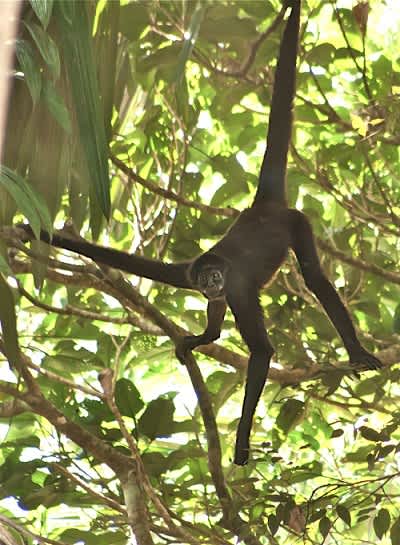Colombia’s National Parks Unit Confirm Rare Brown-Spider Monkey Living in Parque Nacional Natural Selva de Florenci
OutdoorHub 01.26.12

Researchers from The Wildlife Conservation Society’s (WCS) Colombia program and Colombia’s National Parks Unit have confirmed that a critically endangered subspecies of brown-spider monkeys is living in Selva de Florencia National Park in Colombia – the only national protected area with a confirmed population of this extremely rare primate.
The brown-spider monkey (Ateles hybridus) is considered one of the top 25 threatened primate species of the world. The species resides in two separate populations on either side of the Magdalena River in central Colombia, partially within WCS’ Eje Cafetero landscape. Each population represents a different subspecies: A. hybridus hybridus living on one side of the river; A. h. brunneus lives on the other.
Although both subspecies are in danger of extinction, A. h. brunneus is most at risk because no national protected areas contain populations of this uniquely Colombian primate until this recent discovery.
“This exciting discovery of brown spider monkeys in Selva de Florencia National Park emphasizes the importance of protected areas to safeguard wildlife – even for previously unknown species,” said Dr. Julie Kunen, WCS Director of Latin America and Caribbean Programs. “The fact that the species was found in a protected area gives conservationists hope that populations will be safeguarded and can perhaps even grow in number.”
When Selva de Florenica was created as a national park in 2005, the only known evidence of A. h. brunneus was a captive specimen living with colonists in the park. Subsequent studies conducted by WCS, Regional Autonomous Corporation of Caldas, Universidad de Caldas, Universidad Nacional, ISAGEN, and Instituto von Humboldt were unable to locate the species; therefore it was considered most likely extinct in the area.
Then in early November of last year, a local farmer in the village of El Silencio reported the possible presence of the species, setting into motion a rapid exploration of the area by officers of the National Parks Unit and researchers from WCS. At least two individual brown-spider monkeys were observed, making Selva de Florencia National Park the only national protected area that currently protects this subspecies.
Unfortunately, Selva de Florencia National Park is located in the southernmost area of the species’ range making its population even more vulnerable to extirpation. To ensure the conservation of the brown spider monkey in Colombia, next steps will include a rigorous evaluation of the population status of the species in this park and restoration of degraded habitat to provide connectivity with other northern populations currently being studied by WCS.
The Wildlife Conservation Society’s Colombia program, funded in part by the U.S. Fish and Wildlife Service’s Wildlife Without Borders, focuses primarily on conserving central Andean ecosystems and their wildlife, particularly in the mid-portion of the central and western Andean cordilleras and the Cauca River Valley that flows between them. To help build capacity in the region, WCS helps train young conservation professionals and works with governmental and non-governmental organizations, as well as local communities, to implement effective conservation. Additionally, WCS provides technical assistance to conservation initiatives at the national, regional, and local levels.

